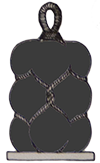SLAVE TRADE and SLAVE SHIPS in the XVIIIth century
Book format: 22 x 31 cm, 160 colour pages including over 200 period illustrations.
Ship log of the Licorne from Bordeaux
Available in English.
 En stock
En stock




They were named Licorne, Marie-Séraphique, Olympe, Aurore and Artibonite. They were sailing the Indian Ocean or the Atlantic to the Antilles to supply France, and the European ports, with these colonial products, which consumption was growing in the cities. But human cargo was piling up high between decks and on deck for the production of these indispensable new riches.
From 1595 to 1866, no less than 27 235 European slave ship expeditions were launched across the Atlantic: of all these expeditions, 3 343 were attributed to French vessels.
What was the slave ship like, how was a slave trade campaign organized, what were the routes followed and the trading sites used, what were the composition and the importance of the cargo to trade and why were there so many weapons to trade?
Patrick Villiers, distinguished university professor in maritime history, five-time prizewinner of the “Académie de Marine”, brings us a few answers supported by archival documents. Slave trade journals are exceedingly rare. The commented publication of the ship log of the Licorne from Bordeaux, which departed for Mozambique in 1788, allows us to further our knowledge in this traffic of human beings, who’s only fault was to have a black skin.
COMPOSITION OF THIS WORK
Book format: 23 x 31 cm, 160 colour pages including over 200 period illustrations.
Table of content:
I- The slave trade in the XVIIIth century, a commerce like all others, blessed by the church and encouraged by the Kingdom, but so vital to our colonies.
II- The French trade in the XVIIIth century, through the example of the port of Nantes.
III- Facing Nantes: the menace from Bordeaux.
IV- Trading sites in Africa, from the Atlantic coast to the Mozambique canal.
V- The Licorne and the types of slave ships, 1763 – 1790.
VI- Food, health and hygiene aboard slave ships, an exemplary captain: Joseph Brugevin.
VII- In search of slave trade profits.
VIII- Trade of Blacks and guns for the trade: the French case.
IX- Joseph Brugevin, from being captain of the Aventurier to being captain of the Licorne, 1769-1787 and colonial arming from Bordeaux in 1787.
List of ships that left from Bordeaux in 1787 for the Antilles, the African coast, the Isle of France and Mozambique.
X- Ship log of the Licorne from Bordeaux.
*******
Complement: List of the plates - slave ships 1776 - 1845
Iris – Hancock, 1776-1788, 700 tons, American frigate captured by the British and then, by the French, armed as a slave ship in La Rochelle, 1783-1788.
1 profile and cut-view plan, 1 frigate interior plan and 1 slave ship interior plan.
Olympe, three-mast slave ship from Nantes, 1789-1793, 300 tons, built in Nantes, armed for the Antilles and as a slave ship to Mozambique.
1 sail plan.
Segunda Teresa, Spanish slave trade brig, schooner-brig rigged, 1828-1840, 144 tons, built in Philadelphia in 1828, captured in 1831 and purchased as a yacht, sold in 1839, renamed Xarifa (image at the top of the page).
1 profile and cut-view plan.
Dos Amigos, renamed Fair Rosamond, originally a Spanish slave ship rigged as a schooner-brig, 1830-1845, 172 tons, built in the Antilles, captured in 1830, in service for the Royal Navy from 1830 to 1845.
1 profile and cut-view plan and 1 sail plan.
Diligente, Portuguese slave ship, rigged as a schooner-brig, 1836-1840, 305 tons, built in the United States, captured twice in 1837 and 1839. One of the fastest slave ships of its time.
(Cover: watercolour artwork by lieutenant Henry Samuel Hawker who served aboard)
1 profile and cut-view plan and 1 sail plan.
EAN : 9782382820049
Author : Patrick VILLIERS translation by GILLES KORENT
No customer comments for the moment.












